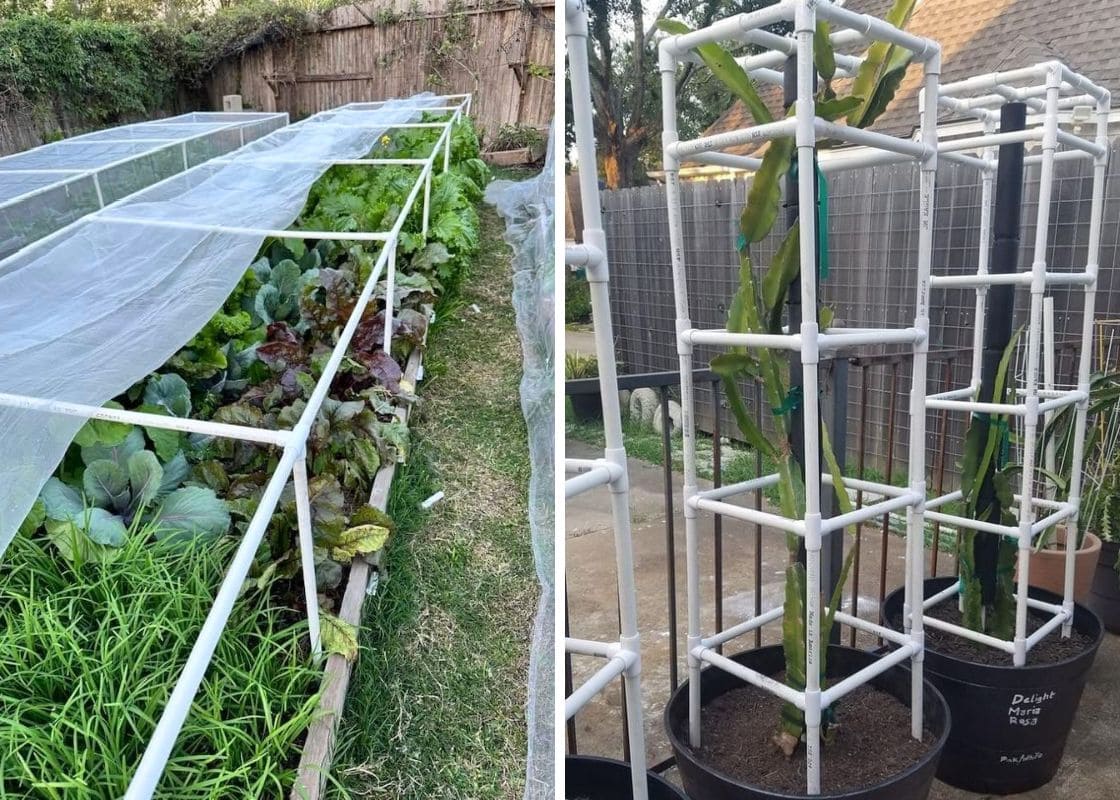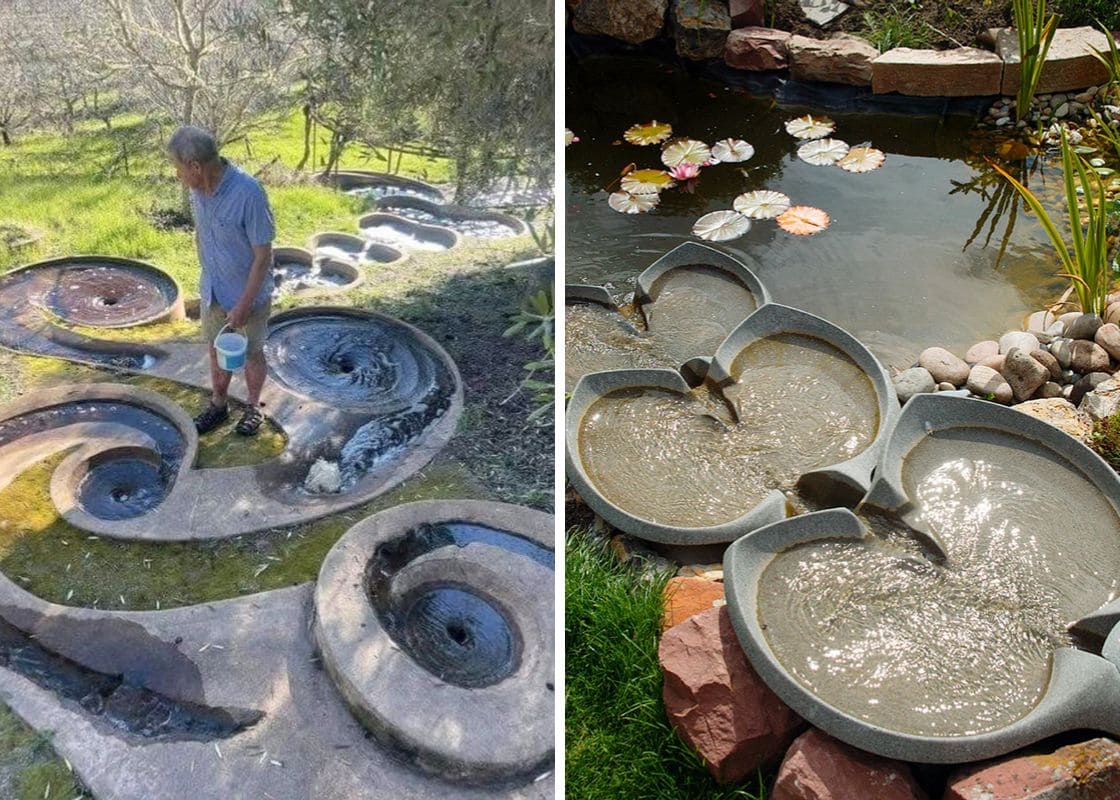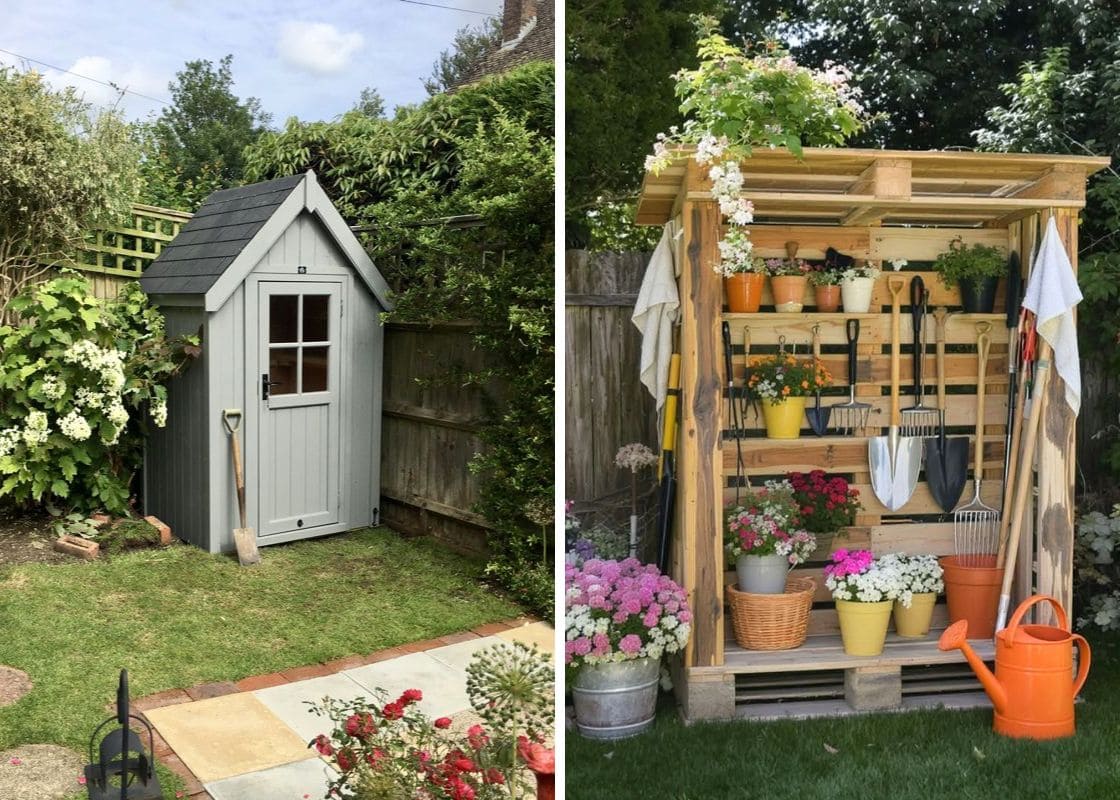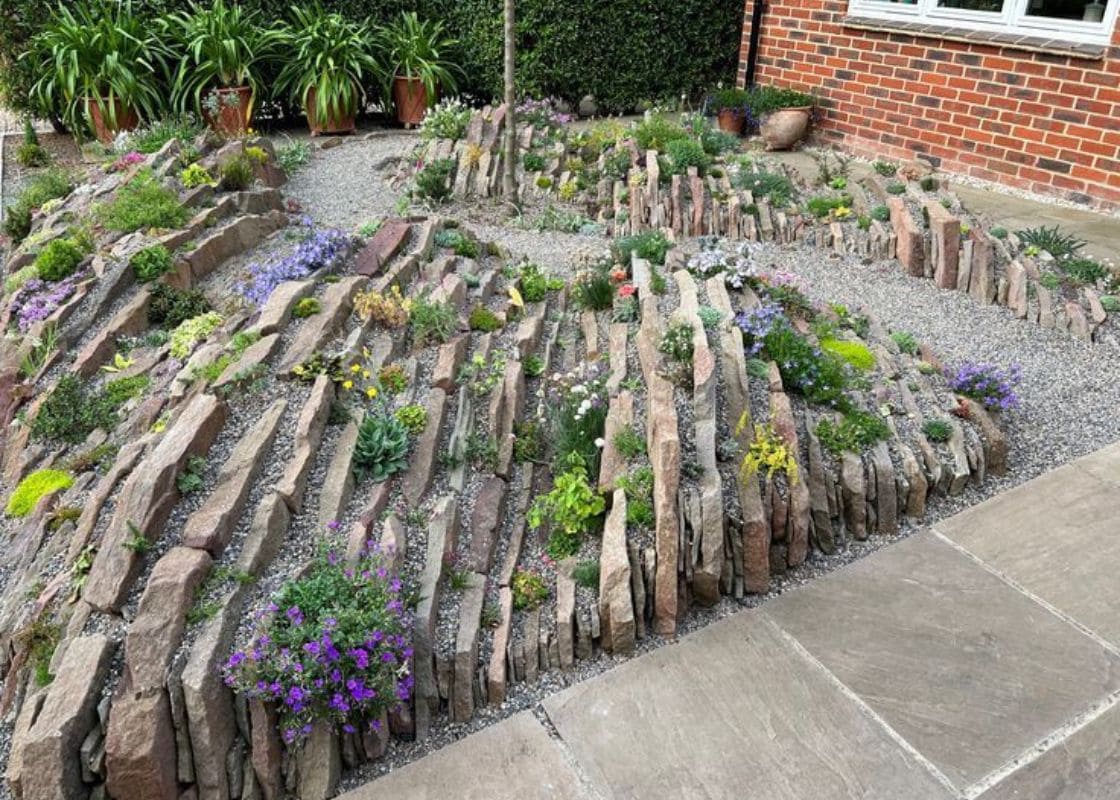A beautiful garden with minimal care is the dream of every gardener. This dream can become a reality with low growing perennial plants.
Low growing perennials are perfect for adding color, texture, and structure to your garden. They come in various colors, shapes, and sizes and ideal for ground cover, borders, and filling in gaps between larger plants.
Instead of looking for methods to improve soil quality, these plants can suppress weeds, conserve moisture, and reduce soil erosion for your garden.
Two-Row Stonecrop (Sedum spurium)
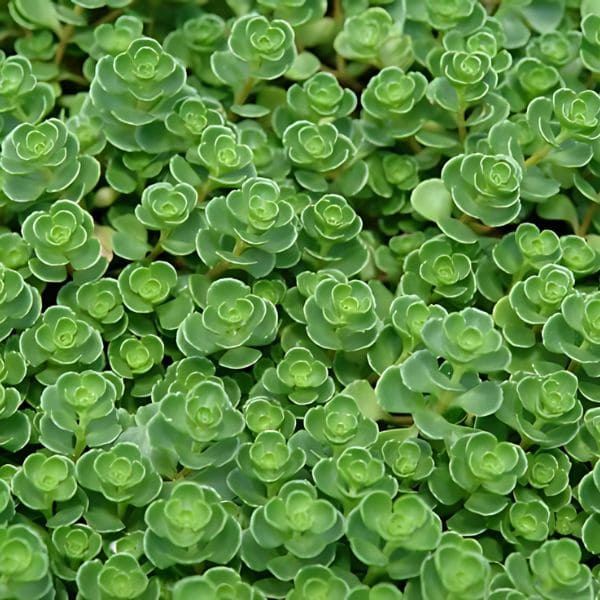
- Height: 2-4 inches
- Sun Exposure: Full sun to partial shade
- Soil pH: Neutral to slightly alkaline
- Hardiness Zones: 3-9
Two-row stonecrop is a low-growing perennial that reaches a modest height of 2-4 inches. It spreads and creates a dense mat.
This hardy plant boasts succulent, evergreen foliage that can vary from bright green to deep red, depending on the season and sun exposure. In summer, it produces clusters of star-shaped pink or red flowers that attract pollinators.
Sedum spurium thrives in well-drained soil with a neutral to slightly alkaline pH. Its drought tolerance and minimal maintenance needs make it perfect for busy gardeners. It is excellent for ground cover, edging, and rock gardens. While generally pest-free, keep an eye out for overwatering which can lead to root rot.
Creeping Phlox (Phlox subulata)
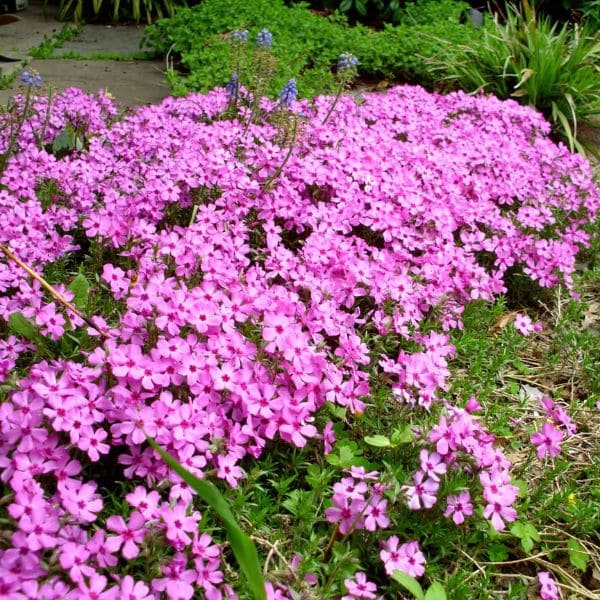
- Height: 4-6 inches
- Sun Exposure: Full sun
- Soil pH: Slightly acidic to neutral
- Hardiness Zones: 3-9
Creeping Phlox reaches a height of 4-6 inches, it spreads to form a dense mat of evergreen foliage. In spring, this charming plant bursts into bloom with masses of star-shaped flowers in shades of pink, purple, blue, or white creating a stunning carpet of color.
This flower thrives in full sun and prefers slightly acidic to neutral soil and is perfect for rock gardens, edging, and as a ground cover. You can also pair it with other spring bloomers like tulips and daffodils for a beautiful garden display.
Creeping Phlox can be propagated through division or stem cuttings. It is low-maintenance and drought-tolerant once established. However, you also need to watch for powdery mildew.
Coral Bells (Heuchera)
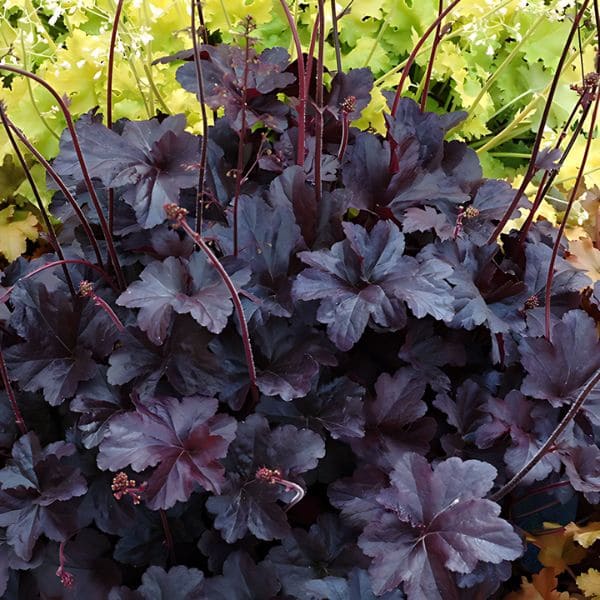
- Height: 12-18 inches
- Sun Exposure: Full sun to partial shade
- Soil pH: Slightly acidic to neutral
- Hardiness Zones: 4-9
With a height of 12-18 inches, coral bells form neat, mounding clumps. Its striking foliage comes in a variety of colors, from deep purple to bright green, and even shades of bronze and silver. In late spring to early summer, it sends up delicate flower spikes adorned with tiny bell-shaped blooms.
This versatile plant thrives in full sun to partial shade and prefers slightly acidic to neutral soil. It pairs beautifully with hostas and ferns. Generally low-maintenance, keep an eye out for vine weevils and ensure good drainage to prevent root rot.
Heuchera is perfect for shady borders, woodland gardens, and as a ground cover. Native American tribes used its roots to treat digestive issues and sore throats. The tannin-rich roots were also used as an astringent to treat wounds and stop bleeding.
Bugleweed (Ajuga reptans)
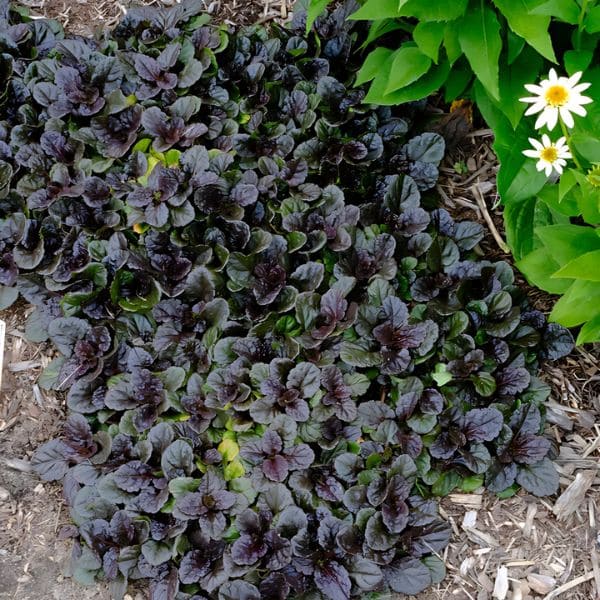
- Height: 4-6 inches
- Sun Exposure: Full sun to partial shade
- Soil pH: Slightly acidic to neutral
- Hardiness Zones: 3-10
Bugleweed reaches 4-6 inches in height and quickly spreads to form a dense, colorful mat. Its glossy, dark green leaves sometimes exhibit hints of purple or bronze.
In late spring, it produces spikes of blue, purple, or white flowers attracting pollinators like bees and butterflies. Besides, herbalists often recommend bugleweed tea to soothe respiratory issues.
Bugleweed thrives in full sun to partial shade and prefers slightly acidic to neutral soil. It’s perfect for ground cover, edging, or filling spaces between stepping stones. This plant pairs well with hostas and ferns. Ensure good air circulation to prevent crown rot and watch for slugs.
Pinks (Dianthus)
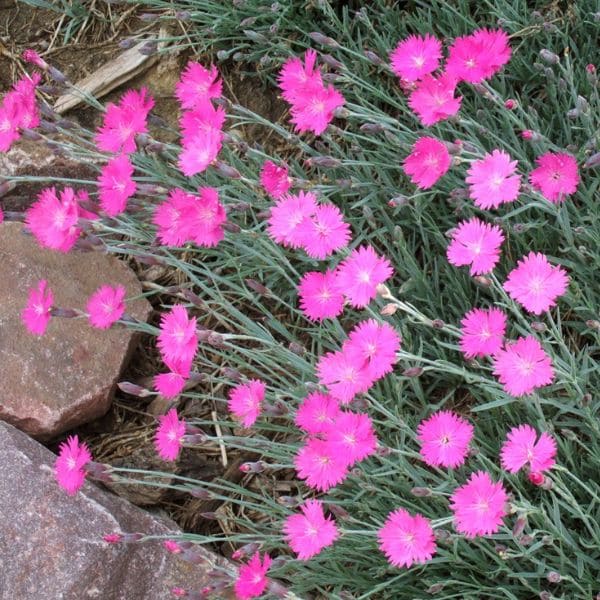
- Height: 6-18 inches
- Sun Exposure: Full sun
- Soil pH: Slightly alkaline to neutral
- Hardiness Zones: 3-9
Commonly known as Pinks, Dianthus plants range from 6-12 inches in height and spread with slender, gray-green leaves. It is also called “Sweet William” symbolizing gallantry and was worn by knights during medieval times.
Dianthus thrives in full sun and prefers slightly alkaline to neutral, well-drained soil. Its flowering period spans from late spring to early summer, offering color and clove-like scent.
Ideal for borders, rock gardens, and container planting, Dianthus pairs well with other sun-loving perennials like Salvia and Lavender. Generally you need to deadhead spent flowers to encourage continuous blooming and watch for potential pests like aphids and slugs.
Creeping Thyme (Thymus Serpyllum)
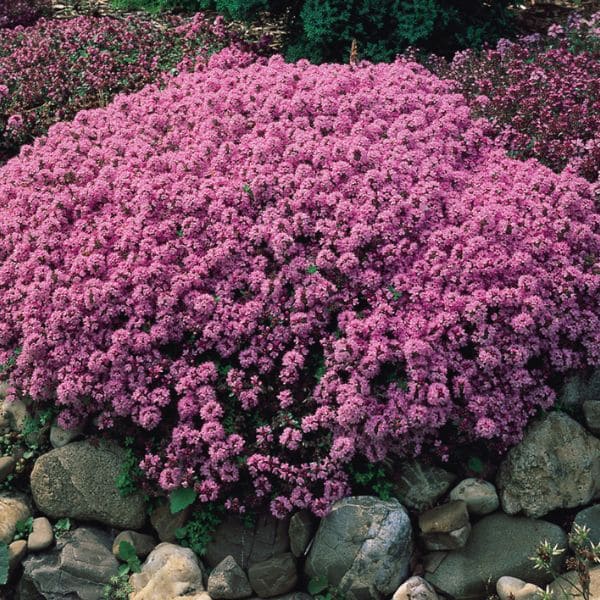
- Height: 2-3 inches
- Sun Exposure: Full sun
- Soil pH: Slightly acidic to neutral
- Hardiness Zones: 4-9
Creeping thyme is a low-growing perennial reaching a modest height of 2-3 inches and spreads to form a dense, fragrant mat. It thrives in full sun and well-drained soil with a slightly acidic to neutral pH.
The tiny, evergreen leaves are aromatic and complemented by clusters of small, pink to purple flowers that bloom in summer, attracting bees and butterflies. It requires little care other than occasional trimming to maintain its shape.
This plant is perfect for filling gaps between stepping stones, as a ground cover, or in rock gardens to prevent soil erosion. It pairs well with other drought-tolerant plants like Sedum and Dianthus.
In addition, its essential oil is used to soothe coughs and colds. Gardeners and chefs also add its delicate, earthy flavor to enhance a multitude of dishes from roasted meats to savory sauces and soups.
Candytuft (Iberis sempervirens)
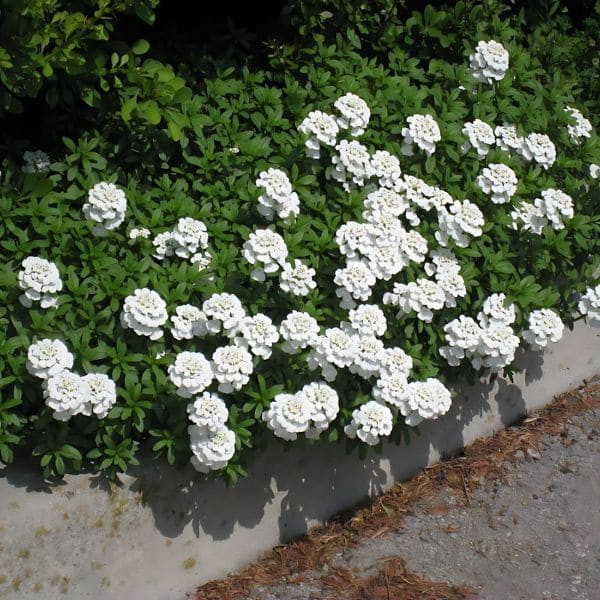
- Height: 8-12 inches
- Sun Exposure: Full sun to partial shade
- Soil pH: Slightly alkaline to neutral
- Hardiness Zones: 3-9
Candytuft grows 8-12 inches tall and spreads to form a low, dense mat with glossy, evergreen foliage. In early to mid-spring, it produces clusters of small, pure white flowers that create a beautiful contrast against its dark green leaves.
This plant is both hardy and versatile, it thrives in full sun to partial shade and prefers slightly alkaline to neutral soil. It also pairs with Phlox subulata and creeping thyme and is ideal for borders, rock gardens, and as ground cover.
Generally low-maintenance, Iberis sempervirens benefit from light pruning after flowering to maintain its shape and encourage new growth. Your task is to keep an eye out for aphids as it is relatively pest-free.
Sea Thrift (Armeria maritima)
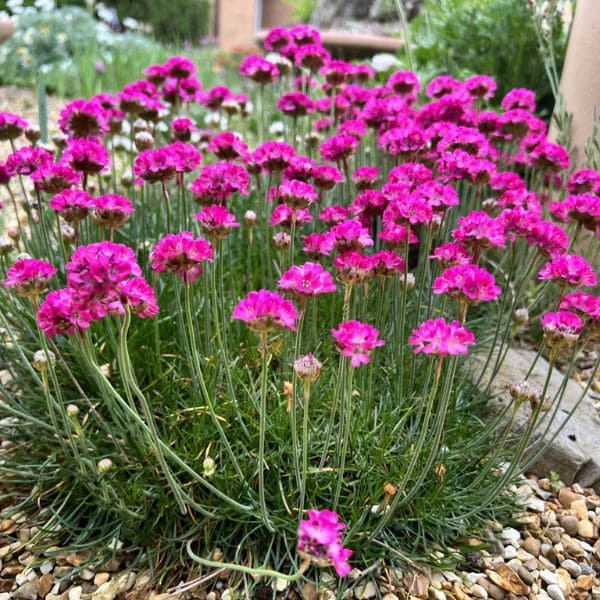
- Height: 6-12 inches
- Sun Exposure: Full sun
- Soil pH: Slightly acidic to neutral
- Hardiness Zones: 4-8
Sea thrift is a hardy perennial that is perfect for gardeners to add a touch of the seaside to their landscapes. It features dense tufts of grass-like, evergreen foliage and produces charming, ball-shaped clusters of pink, white, or lavender flowers on slender stems from late spring to early summer.
This plant thrives in full sun and prefers well-drained, slightly acidic to neutral soil. Therefore, it pairs well with other drought-tolerant perennials like Sedum and Dianthus. You can also use it for rock gardens, borders, and coastal gardens.
It’s relatively low-maintenance, requiring only occasional deadheading to encourage continuous blooms. Be cautious of root rot in poorly drained soils, otherwise, this plant is pest-free.
Snow-in-Summer (Cerastium tomentosum)
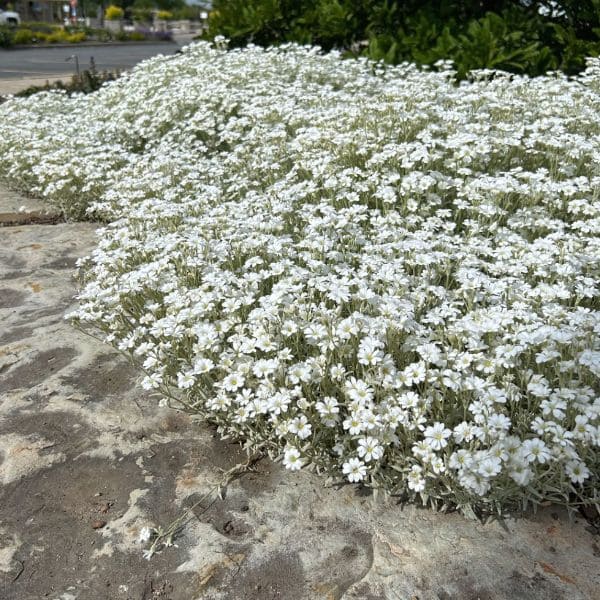
- Height: 6-12 inches
- Sun Exposure: Full sun
- Soil pH: Slightly alkaline to neutral
- Hardiness Zones: 3-7
Snow-in-summer features woolly, silver-gray foliage and produces masses of small, white flowers. This low-growing perennial an create a stunning “snowy” effect in your garden even during the warmest months.
Snow-in-summer thrives in full sun and prefers well-drained, slightly alkaline to neutral soil. It is perfect for rock gardens, borders, and as a ground cover. It pairs beautifully with other sun-loving plants like Lavender and Salvia.
This plant is drought-tolerant and low-maintenance, requiring occasional trimming after flowering to keep it tidy. However, you also need to watch out for overly wet conditions which can lead to root rot.
Carpathian Bellflower (Campanula carpatica)
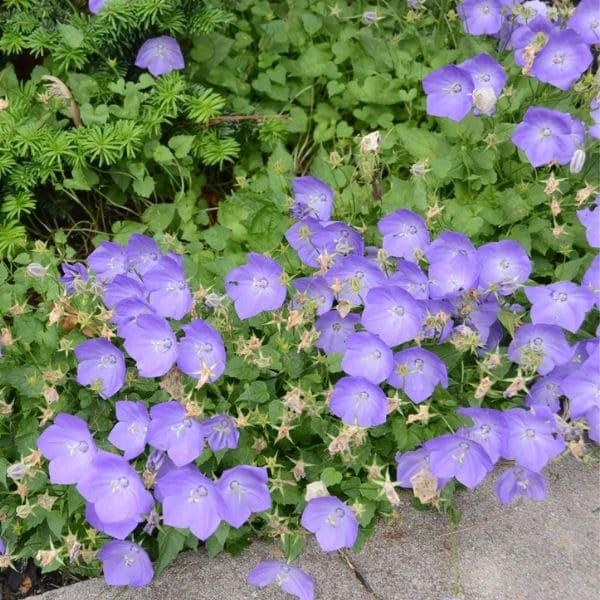
- Height: 6-12 inches
- Sun Exposure: Full sun to partial shade
- Soil pH: Slightly acidic to neutral
- Hardiness Zones: 3-8
Carpathian bellflower is a delightful perennial boasting dainty, cup-shaped flowers in shades of blue, purple, and white and blooming from early summer to early fall. Its lush, green foliage forms a compact mound that thrives in full sun to partial shade and prefers well-drained, slightly acidic to neutral soil.
This versatile plant is ideal for rock gardens, borders, and container planting. It pairs beautifully with other perennials like Dianthus and creeping thyme.
This flower can attract pollinators like bees and butterflies. Moreover, its edible flowers are occasionally used in culinary decorations adding a touch of elegance to salads and desserts.
Generally low-maintenance, Carpathian bellflower requires regular watering and deadheading to encourage continuous blooms. While it’s relatively pest-free, watch out for slugs and snails.
Turkish Speedwell (Veronica oltensis)
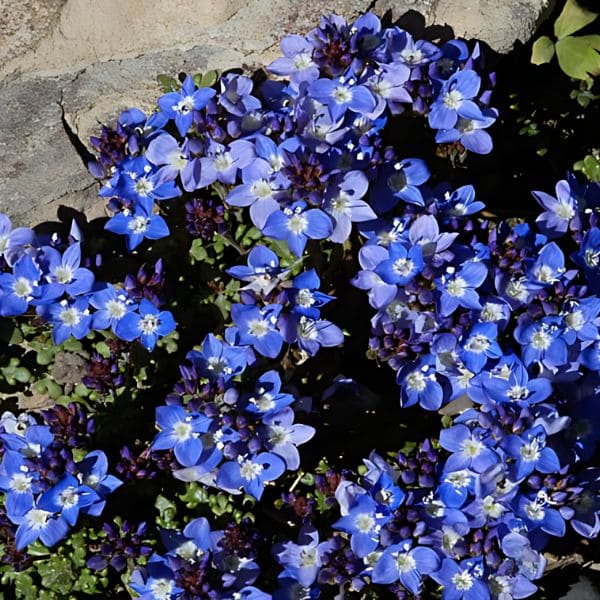
- Height: 1-2 inches
- Sun Exposure: Full sun
- Soil pH: Slightly acidic to neutral
- Hardiness Zones: 4-8
Although growing just 1-2 inches tall, Turkish speedwell spreads to form a dense mat of vibrant foliage. It features small, round leaves that create a lush green carpet. In spring, it produces clusters of bright blue flowers that stand out beautifully against the foliage.
This plant thrives in full sun and prefers well-drained, slightly acidic to neutral soil. It can pair well with other low-growing perennials like creeping thyme and sedum to add color and attract pollinators.
Additionally, traditional herbalists use it to prepare remedies for ailments such as respiratory issues, skin irritations, and digestive disorders.
With minimal watering, Turkish speedwell is ideal for your rock gardens or edging. However, ensure good drainage to prevent root rot and watch for potential pests like aphids.
Mountain Sandwort (Arenaria montana)
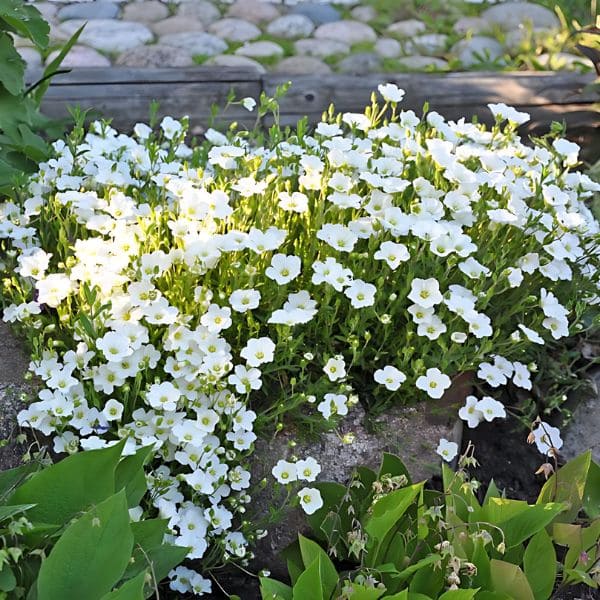
- Height: 4-6 inches
- Sun Exposure: Full sun to partial shade
- Soil pH: Slightly acidic to neutral
- Hardiness Zones: 4-7
Arenaria montana grows to a height of 4-6 inches and spreads to form a dense mat of lush foliage. It boasts small, dark green leaves that provide a beautiful backdrop for its pristine white flowers, which bloom from late spring to early summer.
People believe that hikers and climbers who find this plant on their journeys are blessed with protection and strength.
Thriving in full sun to partial shade, this plant prefers well-drained soil with a slightly acidic to neutral pH. It pairs well with other low-growing perennials like creeping phlox and sedum.
Mountain sandwort is perfect for rock gardens, borders, and as ground cover. With low-maintenance , you only need to ensure good drainage to prevent root rot and keep an eye out for potential pests like aphids.
Irish Moss (Sagina subulata)
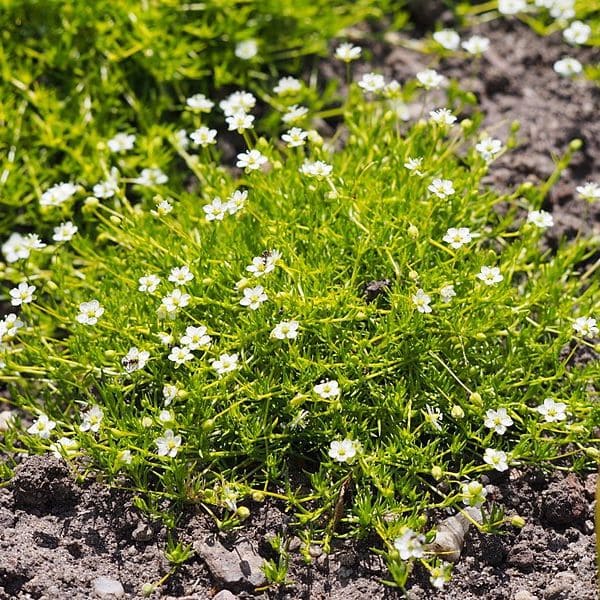
- Height: 1-2 inches
- Sun Exposure: Full sun to partial shade
- Soil pH: Slightly acidic to neutral
- Hardiness Zones: 4-8
With a modest height of 1-2 inches, Irish moss spreads gracefully to form a dense mat of tiny, bright green leaves. This charming plant blooms in late spring to early summer producing small, star-shaped white flowers that add a delicate touch to its vibrant foliage.
Thriving in full sun to partial shade, Irish Moss prefers well-drained soil with a slightly acidic to neutral pH.
Irish Moss is also gaining popularity as an eco-friendly lawn alternative. Unlike traditional grass lawns that require frequent mowing and watering, it is low maintenance.
Sagina subulata is perfect for filling gaps between stepping stones, as a ground cover, or for edging pathways. It pairs beautifully with other low-growing perennials like creeping thyme and sedum.
Creeping Jenny (Lysimachia nummularia)
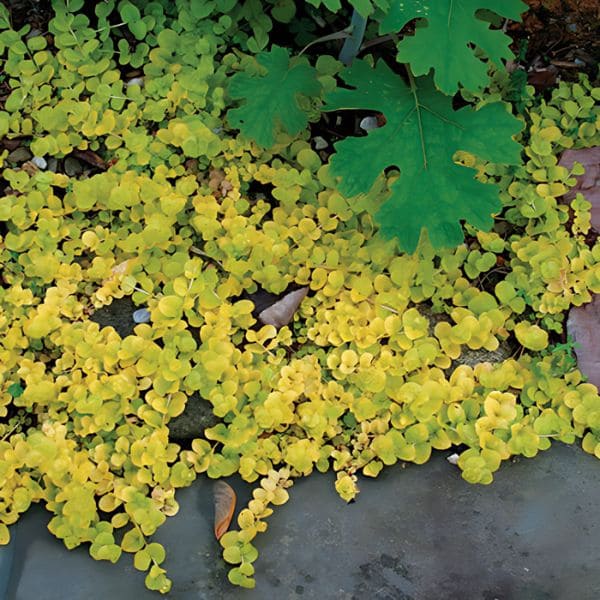
- Height: 2-4 inches
- Sun Exposure: Full sun to partial shade
- Soil pH: Slightly acidic to neutral
- Hardiness Zones: 3-9
Creeping jenny is a low-growing perennial reaching a height of 2-4 inches and featuring round, bright green leaves that turn golden yellow in the fall. It blooms in late spring to early summer producing small, cup-shaped yellow flowers.
This hardy plant grows well with other moisture-loving plants like hostas and ferns. It thrives in full sun to partial shade and prefers well-drained, slightly acidic to neutral soil. So, you can make use of it for ground cover, edging, and hanging baskets.
It’s low-maintenance but requires regular watering to keep the soil moist. Ensure good drainage to prevent root rot, and be mindful of its vigorous spread which can become invasive if not controlled.
Japanese Spurge (Pachysandra terminalis)
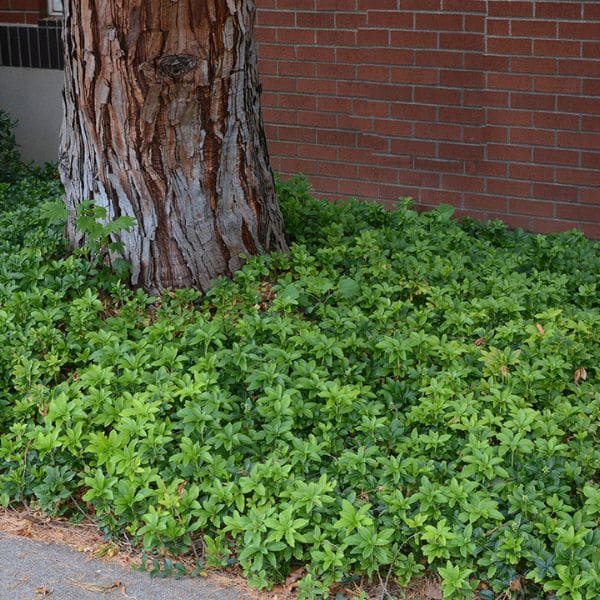
- Height: 6-12 inches
- Sun Exposure: Partial to full shade
- Soil pH: Slightly acidic to neutral
- Hardiness Zones: 4-8
Japanese Spurge is a low-growing perennial that excels in shady areas. With a height up to 12 inches, it spreads to form a dense, evergreen carpet that keeps your garden lush and green year-round.
It originates from the lush woodlands of Japan and parts of China. Its introduction to Western gardens dates back to the early 20th century when botanists and plant enthusiasts sought exotic species to enhance European and American landscapes.
This plant has glossy, dark green leaves that provide a beautiful backdrop for its small, white, fragrant flowers, which bloom in early spring. It thrives in partial to full shade and prefers well-drained, slightly acidic to neutral soil.
Perfect for ground cover in shady borders, under trees, and in woodland gardens, Japanese spurge pairs well with ferns and hostas. Remember to ensure good air circulation to prevent fungal diseases and keep an eye for potential pests like scale insects.
Goldmoss Stonecrop (Sedum acre)

- Height: 2-4 inches
- Sun Exposure: Full sun
- Soil pH: Slightly acidic to neutral
- Hardiness Zones: 3-8
Goldmoss Stonecrop is a delightful low-growing perennial with tiny, succulent leaves that are green year-round and turn a lovely golden color in full sun. In late spring to early summer, it blooms with clusters of small, star-shaped yellow flowers, adding a splash of color to your garden.
This resilient plant thrives in full sun and well-drained soil with a slightly acidic to neutral pH. It’s perfect for rock gardens, ground cover, and edging. Ancient Greeks and Romans used it to treat wounds and ailments.
Sedum acre pairs well with other drought-tolerant perennials like thyme and lavender. This plant is easy to care for. Just ensure good drainage to prevent root rot and watch for potential pests like aphids.
Kamchatka Stonecrop (Sedum kamtschaticum)
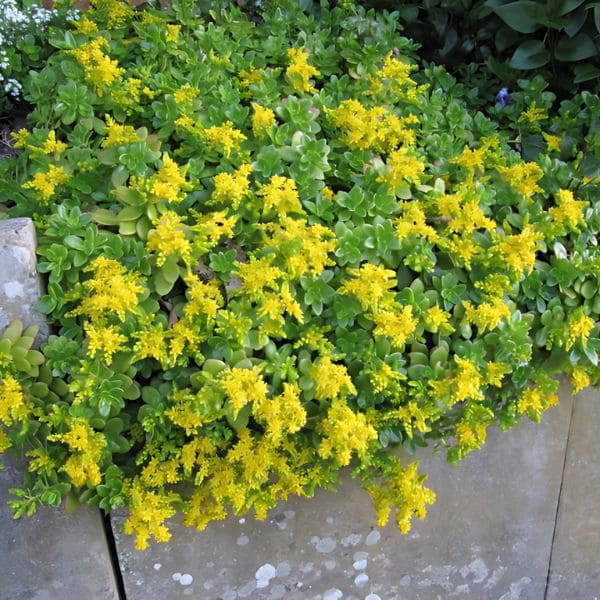
- Height: 4-6 inches
- Sun Exposure: Full sun to partial shade
- Soil pH: Slightly acidic to neutral
- Hardiness Zones: 3-8
Kamchatka Stonecrop is a versatile low-growing perennial perfect for rock gardens, ground cover, and borders. Growing to a height of 4-6 inches, this hardy plant spreads to create a dense mat of foliage.
It features attractive, glossy green leaves that turn reddish-bronze in the fall. From late spring to summer, it blooms with clusters of bright yellow, star-shaped flowers that attract pollinators. This plant thrives in full sun to partial shade and prefers well-drained soil with a slightly acidic to neutral pH.
In modern herbal medicine, extracts from kamchatka stonecrop are prized for their skin-soothing and anti-inflammatory benefits and utilized in salves and ointments.
Kamchatka Stonecrop pairs well with other drought-tolerant plants like lavender and thyme. It is low-maintenance and drought-tolerant, you just ensure good drainage to prevent root rot and watch for potential pests like aphids and slugs.
Blue Spruce Stonecrop (Sedum reflexum)
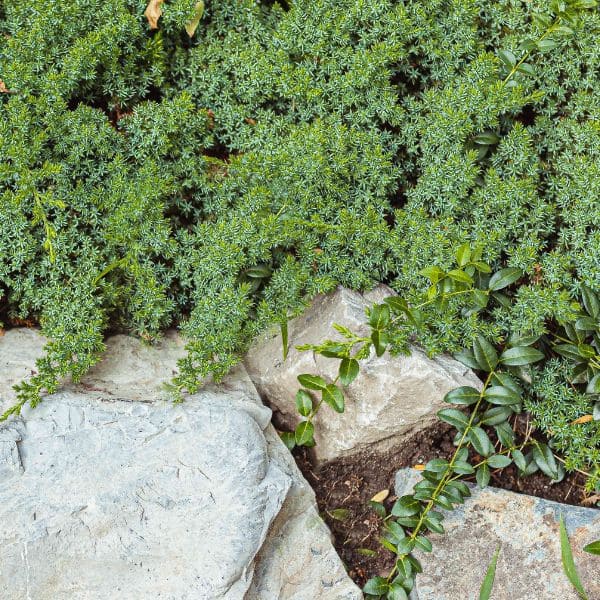
- Height: 3-6 inches
- Sun Exposure: Full sun
- Soil pH: Slightly acidic to neutral
- Hardiness Zones: 3-9
Blue Spruce Stonecrop a height of 3-6 inches. This low-growing perennial forms dense mats of needle-like, blue-green leaves reminiscent of blue spruce trees.
In summer, it produces clusters of bright yellow, star-shaped flowers that attract bees and butterflies. This hardy plant thrives in full sun and prefers well-drained soil with a slightly acidic to neutral pH, so it pairs beautifully with other drought-tolerant perennials like thyme and lavender.
In addition to its landscaping prowess, sedum reflexum can thrive in poor, rocky soils to stabilize disturbed land. It’s low-maintenance and drought-tolerant once established requiring good drainage to prevent root rot, and keeping an eye out for aphids.
White Stonecrop (Sedum album)
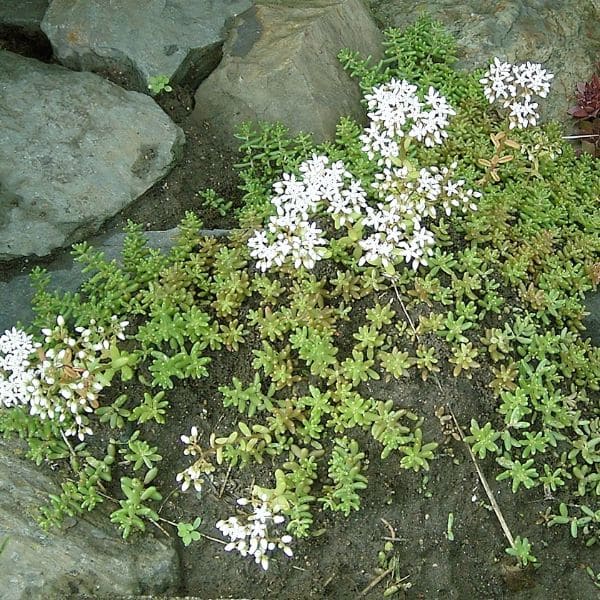
- Height: 3-6 inches
- Sun Exposure: Full sun to partial shade
- Soil pH: Slightly acidic to neutral
- Hardiness Zones: 3-9
With heights of 3-6 inches, white stonecrop features small, succulent leaves that are green in spring and summer, turning reddish in fall and winter.
In early summer, it produces clusters of tiny white flowers that attract pollinators. This hardy plant thrives in full sun to partial shade and prefers well-drained soil with a slightly acidic to neutral pH. It is suitable for rock gardens, ground cover, and green roofs.
Thyme and lavender are great companion plants of white stonecrop. It’s low-maintenance and drought-tolerant once established. Just ensure good drainage to prevent root rot and watch for potential pests like aphids.
October Daphne (Sedum sieboldii)
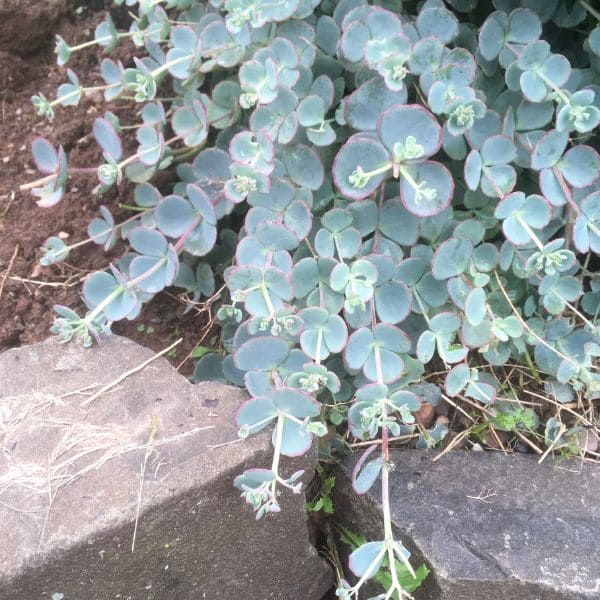
- Height: 6-8 inches
- Sun Exposure: Full sun to partial shade
- Soil pH: Slightly acidic to neutral
- Hardiness Zones: 3-9
October Daphne owns round, blue-green leaves edged in pink, forming attractive mounds. Its mat-forming habit suppresses weeds and prevents soil erosion.
In autumn, it produces clusters of pink star-shaped flowers, providing late-season color when most plants are winding down. This plant thrives in full sun to partial shade and prefers well-drained soil with a slightly acidic to neutral pH.
Ideal for rock gardens, borders, and container planting, october daphne pairs beautifully with other fall bloomers like asters and ornamental grasses. It is easy to grow, just ensure good drainage to prevent root rot and watch for potential pests like slugs and aphids.
Woodland Stonecrop (Sedum ternatum)
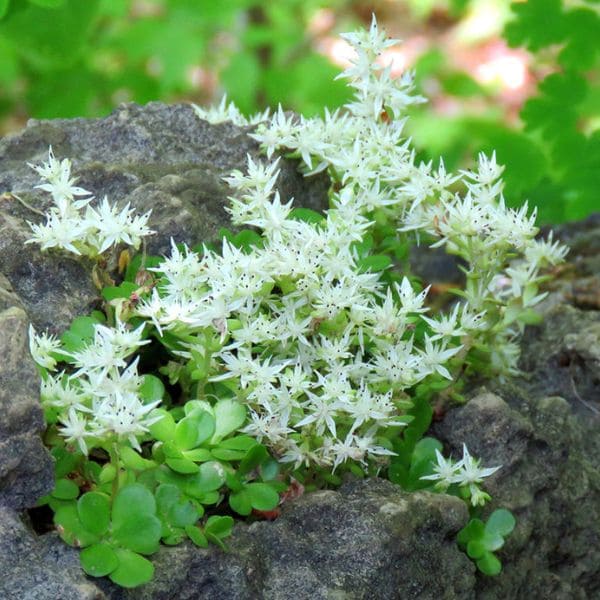
- Height: 3-6 inches
- Sun Exposure: Partial shade to full shade
- Soil pH: Slightly acidic to neutral
- Hardiness Zones: 4-8
Woodland Stonecrop is a low-growing perennial reaching 3-6 inches in height and spreading to form a carpet of greenery. It owns fleshy, green leaves arranged in whorls along its stems.
It is one of the few sedums that thrives in shade and prefers well-drained soil with a slightly acidic to neutral pH. In spring, it blooms with clusters of small, star-shaped white flowers that add a delicate touch to its lush foliage.
Ideal for shady borders, woodland gardens, and ground cover, woodland stonecrop pairs well with hostas and ferns. It’s a low-maintenance plant but you need to watch for potential pests like slugs and snails.
Jelly Bean Plant (Sedum rubrotinctum)
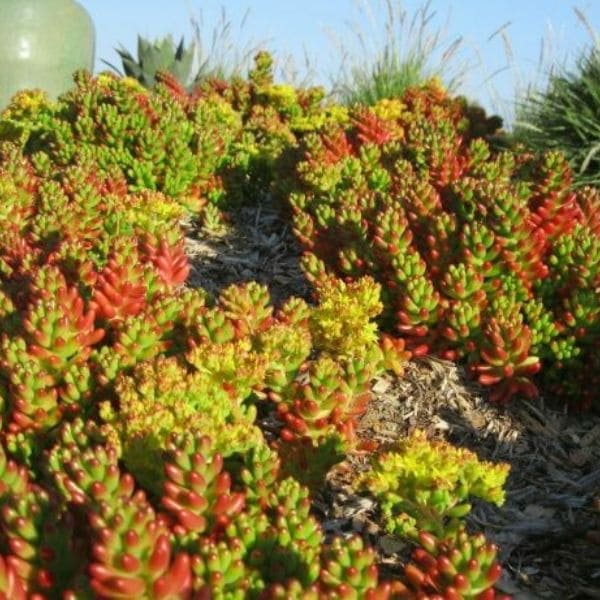
- Height: 4-6 inches
- Sun Exposure: Full sun to partial shade
- Soil pH: Slightly acidic to neutral
- Hardiness Zones: 9-11
Name “Jelly Bean plant” comes from its colorful leaves that resemble jelly beans. It often reaches 4-6 inches in height and features fleshy, cylindrical leaves that are green with red tips, turning more vibrant in full sun.
In spring and summer, it produces small, yellow, star-shaped flowers that contrast beautifully with its foliage. This plant thrives in full sun to partial shade and prefers well-drained soil with a slightly acidic to neutral pH.
Apart from being ornament for rock gardens, containers, and ground cover, in traditional Mexican herbal medicine, the plant is used to alleviate minor skin irritations, much like Aloe Vera.
The Jelly Bean plant pairs well with other succulents like Echeveria and Aloe. It’s low-maintenance and drought-tolerant, requiring minimal watering once established. However, you need to watch for root rot and aphids.
Reflexed Stonecrop (Sedum rupestre)
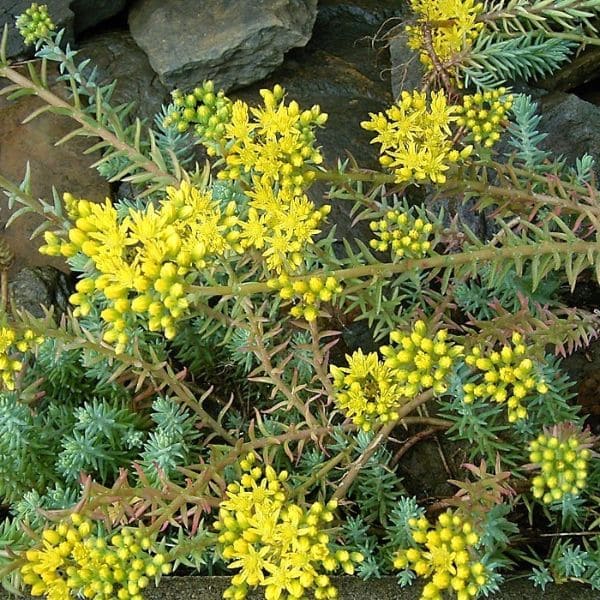
- Height: 4-6 inches
- Sun Exposure: Full sun
- Soil pH: Slightly acidic to neutral
- Hardiness Zones: 3-9
Reflexed stonecrop is renowned for its evergreen foliage forming dense mats of needle-like, blue-green leaves. In summer, it produces clusters of small, bright yellow flowers that create a striking contrast against the foliage.
This plant thrives in full sun and prefers well-drained soil with a slightly acidic to neutral pH. As a result, it pairs beautifully with thyme and lavender. Ensure good drainage to prevent root rot, and watch for potential pests like aphids.
Reflexed stonecrop owns blooms like a focal point in rock gardens and alpine settings. Thanks to its drought tolerance and shallow root system, this plant is ideal for green roofs and living walls in temperature regulation, rainwater absorption, and improving air quality.
Showy Stonecrop (Sedum spectabile)
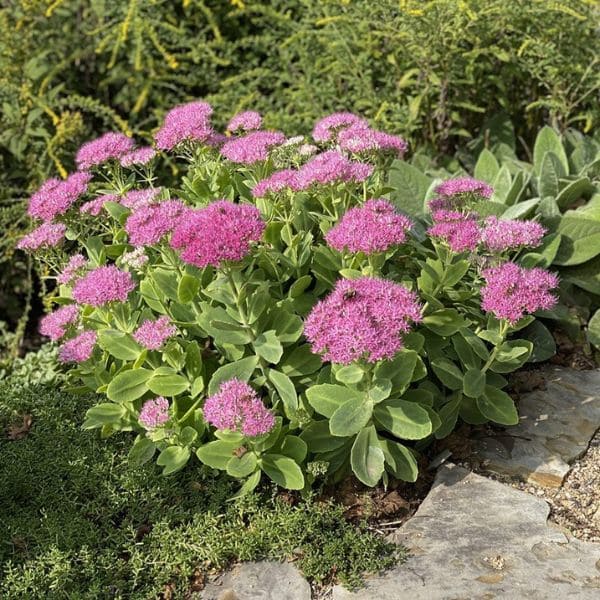
- Height: 12-24 inches
- Sun Exposure: Full sun to partial shade
- Soil pH: Slightly acidic to neutral
- Hardiness Zones: 3-9
Showy stonecrop is a perennial growing 12-24 inches tall and featuring thick, fleshy leaves that are light green and can have a blue-green hue. It produces large, flat clusters of pink, star-shaped flowers that attract butterflies and bees.
Its late blooming period provides much-needed color in autumn when most other plants have faded. This plant thrives in full sun to partial shade and prefers well-drained soil with a slightly acidic to neutral pH.
Ideal for borders, rock gardens, and as a focal point in garden beds, showy stonecrop pairs beautifully with asters and ornamental grasses. Today, Sedum species are proved to contain compounds with potential anti-inflammatory and antioxidant properties.
When caring for this plant, ensure good drainage to prevent root rot and keep an eye out for potential pests like aphids and slugs.
Stringy Stonecrop (Sedum sarmentosum)
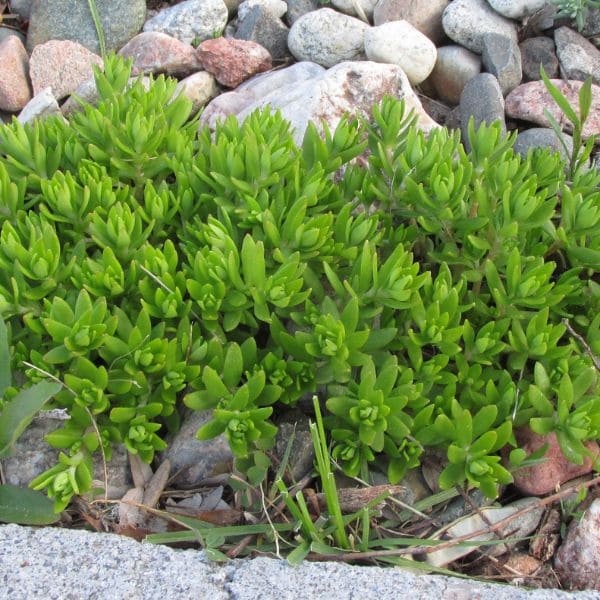
- Height: 4-6 inches
- Sun Exposure: Full sun to partial shade
- Soil pH: Neutral to slightly acidic
- Hardiness Zones: 5-9
Stringy stonecrop is boasts a compact height of 4-6 inches and spreads generously, creating lush mats of succulent foliage. In late spring to early summer, it bursts into clusters of star-shaped yellow flowers, adding a cheerful splash of color.
Sedum sarmentosum thrives in well-drained soil and enjoys full sun to partial shade. It’s remarkably low-maintenance, tolerating drought once established.
In traditional medicine, particularly in Asia, extracts from stringy stonecrop have been applied to minor cuts, burns, and skin irritations to promote healing.
You can pair it with creeping thyme or stonecrop to enhance the beauty of rock gardens, borders, or ground cover. While generally pest-free, keep an eye out for aphids during humid spells.
English stonecrop (Sedum anglicum)
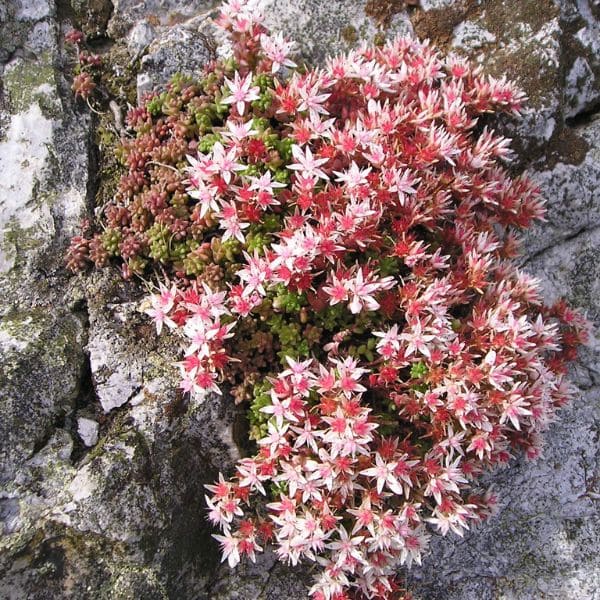
- Height: 4-6 inches
- Sun Exposure: Full sun to partial shade
- Soil pH: Neutral to slightly acidic
- Hardiness Zones: 5-9
English stonecrops own thick, fleshy leaves that are vibrant green, turning reddish in cooler weather, offering visual interest throughout the seasons. It thrives in well-drained soil and enjoys full sun to partial shade, so it is versatile for various garden settings.
Native to the rocky outcrops and coastal cliffs of Western Europe, this stonecrop has adapted to survive in the most challenging environments. Its fleshy, needle-like leaves store water, enabling it to endure drought and poor soil conditions.
In urban areas, it is increasingly used in green roofing projects to improve insulation and reduce stormwater runoff. Gardeners often use it as ground cover that suppresses weeds and stabilizes soil.
This easy-care plant requires minimal watering once established and is resistant to most pests and diseases. In addition, you can pair English stonecrops with other low-growing perennials like creeping thyme or saxifrage.
Golden Sedum (Sedum adolphii)
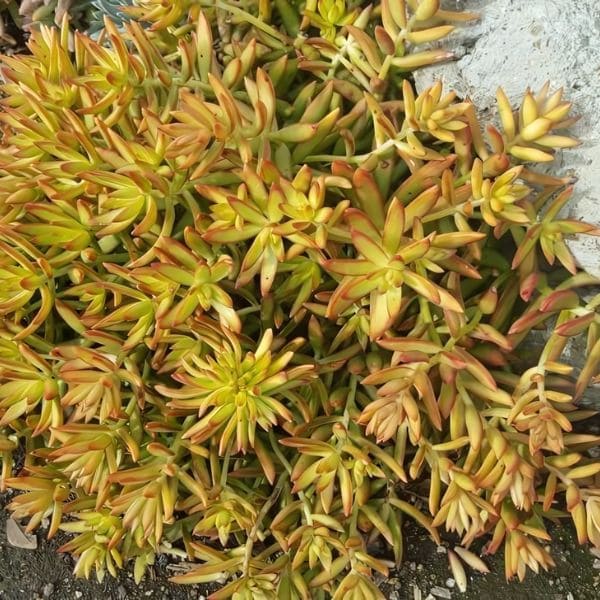
- Height: 4-6 inches
- Sun Exposure: Full sun to partial shade
- Soil pH: Slightly acidic to neutral
- Hardiness Zones: 9-11
Golden sedum forms rosettes of fleshy, spoon-shaped leaves that start off green and develop beautiful golden and orange hues when exposed to full sun. In spring and summer, it produces clusters of small, star-shaped white flowers that add a delicate touch to its vibrant foliage.
This plant thrives in full sun to partial shade and prefers well-drained soil with a slightly acidic to neutral pH. You can pair it with other succulents like Echeveria and Aloe to make your garden covered by colors.
Golden sedum is incredibly easy to propagate. Simply taking a leaf cutting and allowing it to dry before planting can produce a new plant. When caring for it, you only sure good drainage to prevent root rot.
Corsican Stonecrop (Sedum dasyphyllum)
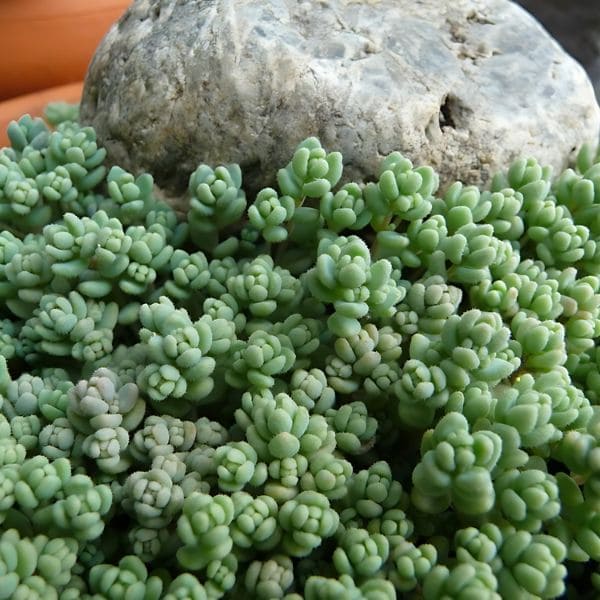
- Height: 2-4 inches
- Sun Exposure: Full sun to partial shade
- Soil pH: Slightly acidic to neutral
- Hardiness Zones: 5-9
Corsican Stonecrop is renowned for its tiny, blue-green, succulent leaves that turn a lovely shade of pinkish-purple in full sun. In summer, it produces small, white to pale pink star-shaped flowers that add a touch of elegance.
This hardy plant thrives in full sun to partial shade and prefers well-drained soil with a slightly acidic to neutral pH. Ideal for rock gardens, between stepping stones, and as ground cover, corsican stonecrop pairs well with other low-growing succulents like Sedum album and creeping thyme.
This plant is low-maintenance and drought-tolerant once established. Ensure good drainage to prevent root rot, and keep an eye out for potential pests like aphids.
Carpet Sedum (Sedum lineare)
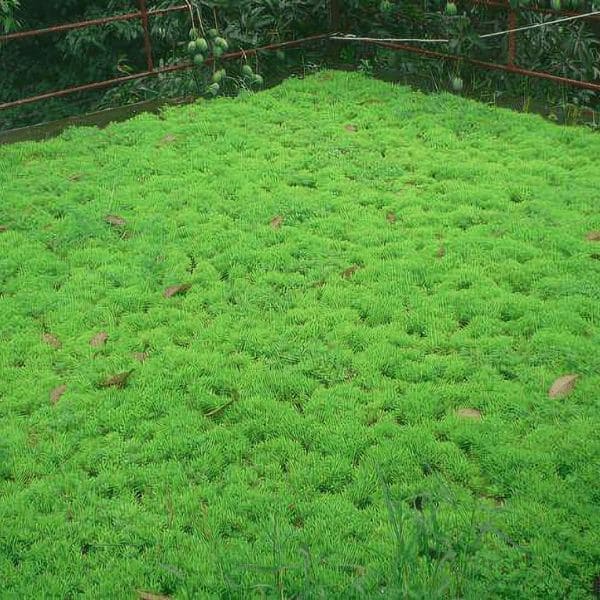
- Height: 3-6 inches
- Sun Exposure: Full sun to partial shade
- Soil pH: Slightly acidic to neutral
- Hardiness Zones: 6-9
Although reaching heights of just 2-4 inches, carpet sedum features slender, linear leaves that are bright green and create a dense mat. In summer, this plant blooms with clusters of small, star-shaped yellow flowers that add a cheerful pop of color.
This plant thrives in full sun to partial shade and prefers well-drained soil with a slightly acidic to neutral pH. It’s low-maintenance and drought-tolerant once established, requiring minimal watering.
Originating from East Asia, this succulent has woven its way into global horticulture as a gem for rock gardens, ground cover and containers.
You can be creative by pairing this plant with other succulents like Sedum album and Echeveria. Besides, watch for potential pests like aphids.
Sweet Violet (Viola odorata)
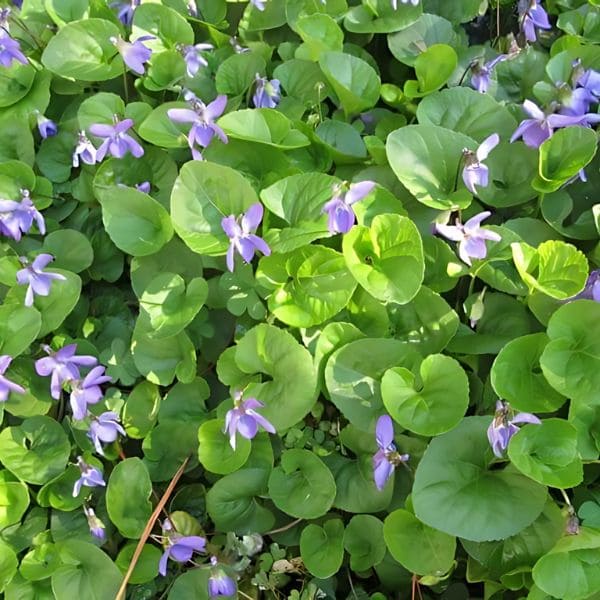
- Height: 4-6 inches
- Sun Exposure: Partial shade to full shade
- Soil pH: Slightly acidic to neutral
- Hardiness Zones: 4-9
Sweet violet is a low-growing perennial reaching a height of 4-6 inches and having heart-shaped, dark green leaves. It produces small, fragrant purple or white flowers in early spring.
This plant thrives in partial to full shade and prefers well-drained, slightly acidic to neutral soil. It’s low-maintenance, but remember to water regularly to keep the soil moist. You also need to watch for potential pests like slugs and snails.
Today, it can pair well with ferns and hostas making beautiful landscapes for shady borders, woodland gardens, and ground cover. Besides, its leaves and flowers are infused into teas, syrups, and tinctures.
The flowers also serve culinary purposes adding a hint of sweetness to salads and desserts. Moreover, their essential oils are valued in perfumery for their soft, floral notes.


